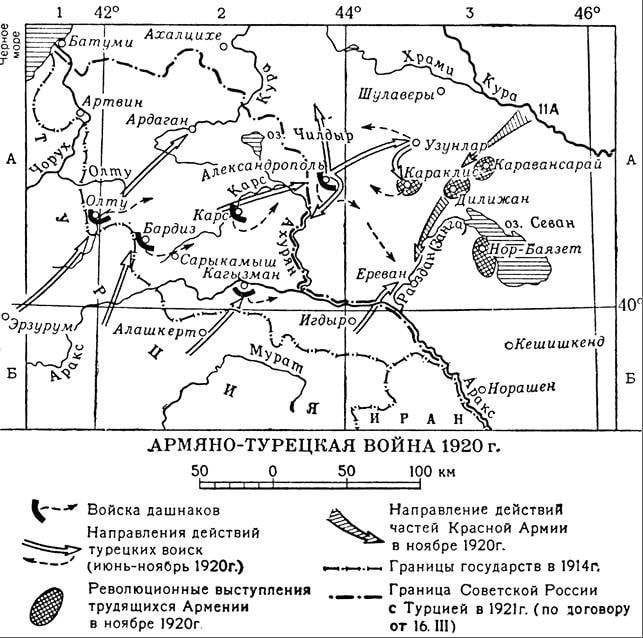The role of Soviet diplomacy in resolving the Armenian-Turkish conflict in 1920

The Turkish side, at a difficult time for it, took the initiative in establishing bilateral relations. A delegation led by Sami Bey was sent to Moscow to conduct negotiations. At the end of August 1920, the Soviet government was able to initial the agreed articles of the Soviet-Turkish treaty. After initialing the future treaty, which was a serious event in strengthening Soviet-Turkish relations, the Turkish military commission remained in Moscow to discuss the list of military materials requested by the Turkish side. Despite its limited capacity, the party was immediately prepared. weapons. In addition, an agreement was reached on financial assistance in the amount of 5 million gold rubles. The help of the RSFSR played an extremely important role in the struggle of the Turkish people for their independence. Especially since it was timely, since the Anglo-Greek troops advanced far into Anatolia.
However, the establishment of strong friendly ties with Soviet Russia was delayed as a result of the hostility towards the Sami talks. In his reports to Kemal he disoriented the Turkish government, biasedly covered the policy of the RSFSR and the course of negotiations in Moscow, which made it difficult to sign the treaty. There were also opponents of Kemal’s foreign policy in the Great National Assembly. All this for six months delayed the signing of the friendship treaty between Moscow and Ankara. During this time, the Soviet government had to deal with the provocative policy of the Entente, which tried to thwart the conclusion of the Soviet-Turkish treaty. [6]
Soviet Russia, the first to recognize the Kemal government, was the first to send its diplomatic representatives to Ankara. The opening of the Soviet embassy in Ankara took place on November 7 1920 [7].
After the Dashnak detachments, despite the material support of the Entente and the USA, suffered a series of defeats due to the numerical superiority of the enemy, the Soviet government offered Armenia a mediation. The Dashnaks also rejected this proposal, hoping for help from the Entente and the United States. The Western powers were counting on complications between Soviet Russia and Turkey and prepared at the expense of Armenia to reach an agreement with Turkey and use it in anti-Soviet actions in the Caucasus. Menshevik Georgia refused to help Armenia and 6 November declared its neutrality. In the end, the November Dashnaks were forced to conclude a truce, and on December 18 signed the Treaty of Alexandropol [2], under which Armenia became, in fact, the satellite of Turkey. However, Dashnaks no longer had the right to sign the treaty, since on November 8 Soviet power was established in Armenia. [29] The Soviet Government of Armenia did not recognize this treaty. Nor did he recognize the government of the RSFSR [9].
The Dashnak-Kemalist war complicated the situation in the Caucasus and created tension in the Soviet-Turkish relations. However, the plans of the Entente failed. Lenin noted: “The Turkish offensive was calculated against us. The Entente dug a hole for us and got into it itself, for we got Soviet Armenia ”[11].
The establishment of Soviet power in Armenia meant for the Turkish side the need for new negotiations with the government of Soviet Russia, in order to ascertain the latter’s position on the Turkish-Armenian border and, if possible, obtain confirmation of the effectiveness of the Alexandropol Treaty. Therefore, at the end of November 1920, the Ankara government turned to the Soviet side with a proposal to convene a Soviet-Turkish conference, which met with a positive response from the RSFSR government. 7 December 1920. The Plenum of the Central Committee of the RCP (B.) Considered Chicherin's proposal for an agreement with Turkey and instructed the NKID to work out a draft agreement and submit it for approval by the Central Committee [12].
Thanks to the activity of Soviet diplomacy and the realistic position taken by Kemal, the difficulties in Soviet-Turkish relations were successfully overcome. In early December, the question of convening a Soviet-Turkish conference for drafting and signing a political treaty was agreed in principle. Moscow was chosen as the venue for the conference, where the Turkish delegation arrived on February 18 1921. The negotiating instructions received from Lenin said that it was necessary to start “the beginning of rapprochement and friendship extremely firmly” [13].
Notes:
[1] Armenian nationalists united in 1890 in the Dashnaktsutyun (Armenian Revolutionary Alliance) party.
[2] The dividing line established by Great Britain unilaterally in the North Caucasus, running along the Caucasus Mountains from Petrovsk-port (Makhachkala) to Tuapse. It was named for the British General J. Milne.
[3] Chicherin G.V. Articles and speeches on international cooperation. M., 1961, p. 196.
[4] Documents of the USSR foreign policy. T. II, p. 555.
[5] Documents of the USSR foreign policy. T. III, p. 325.
[6] Bagirov Yu.A. Of stories Soviet-Turkish relations in 1920-1922. Baku, 1965, p. 37-41.
[7] Kireev N.G. History of Turkey: XX century. M., 2007, p. 143.
[8] Alexandropol was called Leninakan from 1924, from 1991 it was called Gyumri.
[9] See: Kadishev, A.B. Intervention and civil war in Transcaucasia. M., 1960; Bagirov Yu.A. From the history of Soviet-Turkish relations in 1920-1922. Baku, 1965; Galoyan G. The struggle for Soviet power in Armenia. M., 1957.
[10] History of international relations and foreign policy of the USSR. T. 1. M., 1986, p. 92-93.
[11] Lenin V.I. Concluding Remarks on the Concessions Report on the Faction of the RCP (b) VIII Congress of Soviets 21 December 1920. - In the book: PSS. 5 ed. T. 42. M., 1970, p. 125.
[12] Heifetz A.N. Soviet diplomacy and the peoples of the East (1921-1927). M., 1968, p. 83.
[13] Kuznetsova S.I. The establishment of the Soviet-Turkish relations. M., 1961, p. 47.
An excerpt from the book by Pavel Gusterin "Soviet diplomacy in the Muslim East in 1917-1921" (Saarbrucken, 2014)
Information